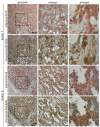Glycodelin is a potential novel follow-up biomarker for malignant pleural mesothelioma
- PMID: 27713145
- PMCID: PMC5342078
- DOI: 10.18632/oncotarget.12474
Glycodelin is a potential novel follow-up biomarker for malignant pleural mesothelioma
Abstract
Malignant pleural mesothelioma (MPM) is a rare and aggressive tumor with a short survival time arising from the mesothelial cells of the pleura. Soluble mesothelin-related peptide (SMRP), osteopontin or EFEMP1 (Fibulin-3) are well described biomarkers for malignant mesothelioma with moderate sensitivity and specificity. In this study, we characterized the expression of glycodelin, a marker for risk pregnancy, in MPM by RNA and protein analyses and investigated its potential as a MPM biomarker. We were able to detect glycodelin in the serum of MPM patients. Compared to benign lung diseases, the serum levels were significant increased. Patients with high glycodelin serum levels revealed a worse overall survival. The glycodelin serum levels correlated with the tumor response to treatment. A comparison of SMRP and glycodelin serum measurement in a large patient cohort demonstrated that the detection of both soluble factors can increase the reliable diagnostic of MPM. Glycodelin was highly expressed in MPM tumors. Analyses of a tissue micro array indicated that the immunomodulatory form glycodelin A was expressed in MPM and correlated with the survival of the patients. Altogether, glycodelin seems to be a new potential biomarker for the aggressive malignant pleural mesothelioma.
Keywords: MPM; SMRP; biomarker; follow-up; glycodelin.
Conflict of interest statement
The authors declare no potential conflict of interest.
Figures






References
-
- Borasio P, Berruti A, Bille A, Lausi P, Levra MG, Giardino R, Ardissone F. Malignant pleural mesothelioma: clinicopathologic and survival characteristics in a consecutive series of 394 patients. European journal of cardio-thoracic surgery. 2008;33:307–313. - PubMed
-
- Leuzzi G, Rea F, Spaggiari L, Marulli G, Sperduti I, Alessandrini G, Casiraghi M, Bovolato P, Pariscenti G, Alloisio M, Infante M, Pagan V, Fontana P, et al. Prognostic Score of Long-Term Survival After Surgery for Malignant Pleural Mesothelioma: A Multicenter Analysis. The Annals of thoracic surgery. 2015 - PubMed
-
- Robinson BW, Lake RA. Advances in malignant mesothelioma. The New England journal of medicine. 2005;353:1591–1603. - PubMed
-
- Fennell DA, Gaudino G, O'Byrne KJ, Mutti L, van Meerbeeck J. Advances in the systemic therapy of malignant pleural mesothelioma. Nature clinical practice Oncology. 2008;5:136–147. - PubMed
-
- Santoro A, O'Brien ME, Stahel RA, Nackaerts K, Baas P, Karthaus M, Eberhardt W, Paz-Ares L, Sundstrom S, Liu Y, Ripoche V, Blatter J, Visseren-Grul CM, Manegold C. Pemetrexed plus cisplatin or pemetrexed plus carboplatin for chemonaive patients with malignant pleural mesothelioma: results of the International Expanded Access Program. Journal of thoracic oncology. 2008;3:756–763. - PubMed
MeSH terms
Substances
LinkOut - more resources
Full Text Sources
Other Literature Sources
Medical
Research Materials
Miscellaneous

